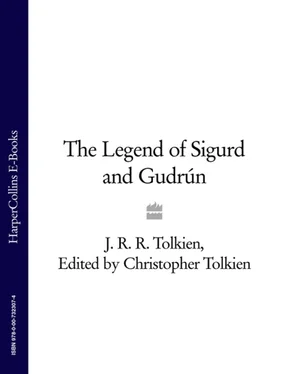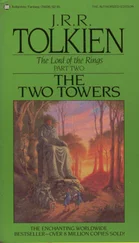J. Tolkien - The Legend of Sigurd and Gudrún
Здесь есть возможность читать онлайн «J. Tolkien - The Legend of Sigurd and Gudrún» — ознакомительный отрывок электронной книги совершенно бесплатно, а после прочтения отрывка купить полную версию. В некоторых случаях можно слушать аудио, скачать через торрент в формате fb2 и присутствует краткое содержание. Жанр: Старинная литература, на английском языке. Описание произведения, (предисловие) а так же отзывы посетителей доступны на портале библиотеки ЛибКат.
- Название:The Legend of Sigurd and Gudrún
- Автор:
- Жанр:
- Год:неизвестен
- ISBN:нет данных
- Рейтинг книги:5 / 5. Голосов: 1
-
Избранное:Добавить в избранное
- Отзывы:
-
Ваша оценка:
- 100
- 1
- 2
- 3
- 4
- 5
The Legend of Sigurd and Gudrún: краткое содержание, описание и аннотация
Предлагаем к чтению аннотацию, описание, краткое содержание или предисловие (зависит от того, что написал сам автор книги «The Legend of Sigurd and Gudrún»). Если вы не нашли необходимую информацию о книге — напишите в комментариях, мы постараемся отыскать её.
The Legend of Sigurd and Gudrún — читать онлайн ознакомительный отрывок
Ниже представлен текст книги, разбитый по страницам. Система сохранения места последней прочитанной страницы, позволяет с удобством читать онлайн бесплатно книгу «The Legend of Sigurd and Gudrún», без необходимости каждый раз заново искать на чём Вы остановились. Поставьте закладку, и сможете в любой момент перейти на страницу, на которой закончили чтение.
Интервал:
Закладка:
7 It is told in the Saga, at the time of the bread-making incident, when Sinfjötli kneaded in a poisonous snake (see note to II.33–34), that Sigmund could not be harmed by poison within or without, whereas Sinfjötli could only withstand poison externally; the same is said in Frá dauða Sinfjötla and in the Prose Edda.
9–10 In both sources Sigmund said to Sinfjötli, when Borghild offered him drink for the third time: Láttu grön sía, sonr (‘Strain it through your beard, my son’). Sigmund was very drunk by then, says the Saga, ‘and that is why he said it’.
12 The boatman was Ódin (the verses describing him here are repeated in varied form in IV.8). This is not said in the old sources. In those texts the boatman offered to ferry Sigmund across the fjord, but the boat was too small to take both Sigmund and the body of Sinfjötli, so the body was taken first. Sigmund walked along the fjord, but the boat vanished. The Saga tells that Borghild was banished, and died not long after.
13 in Valhöllu : the Norse dative inflexion is retained for metrical reasons.
IV FŒDDR SIGURÐR (Sigurd born)
After the expulsion of Borghild Sigmund took another wife very much younger than himself (IV.2), and she was the mother of Sigurd. In the Saga and in Fra dauða Sinfjötla her name was Hjördis, the daughter of King Eylimi; whereas in the Lay she is Sigrlinn. This difference depends on the view that a transference of names took place: that originally in the Norse legends Hjördis was the mother of Helgi (see the note to III), while Sigrlinn was Sigmund’s wife and Sigurd’s mother. After this transference Sigrlinn became the mother of Helgi (and so appears in the Eddaic poem Helgakviða Hjörvarðssonar , the Lay of Helgi son of Hjörvarð) and Hjördis became the mother of Sigurd. In the German poem Nibelungenlied , written about the beginning of the thirteenth century, Sieglind (Sigrlinn) was King Siegmund’s queen, the mother of Siegfried (Sigurd).
The narrative in this section of the Lay has been changed and reduced from that in the Saga (to which there is no poetry corresponding in the Edda). In the Saga, King Lyngvi was a rival to Sigmund for the hand of Hjördis, but Hjördis rejected him; and it was Lyngvi, not the seven suitors, ‘sons of kings’, of the Lay (stanzas 3 and 5), who came with great force against Sigmund in his own land.
Hjördis accompanied only by a bondwoman was sent into the forest and remained there during the fierce battle. In the Saga as in the Lay (stanzas 8–9) Ódin appeared, and Sigmund’s sword (‘Grímnir’s gift’, 5) broke against the upraised spear of the god, and he was slain (on the significance of Ódin’s intervention see the note on the section Upphaf, pp.185–86).
As in the Lay, in the Saga Hjördis (Sigrlinn) found Sigmund where he lay mortally wounded on the battlefield, and he spoke to her, saying that there was no hope of healing and he did not wish for it, since Ódin had claimed him (stanza 11); he spoke also of Sigurd, her son unborn, and told her to keep the shards of the sword, which should be made anew.
Immediately upon Sigmund’s death, a further fleet came in to the shore, commanded, it is said in the Saga, by Alf son of King Hjálprek of Denmark (stanza 14 of the Lay, where the newcomers are not named). Seeing this Hjördis ordered her bondwoman to exchange clothes with her, and to declare that she was the king’s daughter. When Alf returned with the women, still disguised, to his own country the truth of the subterfuge emerged. Alf promised to marry Hjördis after her child was born, and so it came about that Sigurd was brought up in King Hjálprek’s household. In the Lay the curious story of the disguising of Sigrlinn (Hjördis) is reduced to the words ‘The bride of Sigmund / as a bondwoman / over sounding seas / sadly journeyed’.
11 ‘wanhope’: despair.
13 In the Saga Sigmund named the sword that should be made from the shards Gramr ; this appears in the next section of the Lay, V.18.
V REGIN
The sources of the story in this section of the Lay are not only the Völsunga Saga but also poems of the Edda on which the Saga drew: the conclusion of Reginsmál (see the note to section I, p.188), and Fáfnismál ; the story is also briefly told by Snorri Sturluson in the Prose Edda, whereby he explains why ‘gold’ is called in poetry ‘the abode of Fáfnir’ and ‘Grani’s burden’.
There is little, in strictly narrative terms, in this part of the Lay that is not found in these sources, and in places (notably in the dialogue between Sigurd and Regin after Fáfnir’s death) the tenor of the verses of Fáfnismál is followed; but only here and there do they correspond at all closely.
The legend of ‘Andvari’s gold’ as told in section I of the Lay does not extend beyond the departure of the Æsir from Hreidmar’s house after the payment of the ransom for his son Otr. In the note to that section (p.190) I have noticed that Snorri Sturluson in his version of the Völsung legend began with ‘Andvari’s gold’, whereas in the Saga it is not introduced until much later, and enters as a story told by Regin himself, son of Hreidmar, to Sigurd before his attack on the dragon. In this section of the Lay we reach that point.
After telling that Sigurd grew up in the house of King Hjálprek the Saga says no more than that Regin became his fosterfather, and that he taught Sigurd many accomplishments, including a knowledge of runes and many languages (see stanza 2). Snorri, on the other hand, continues the story of Hreidmar and the gold of Andvari beyond the point where my father left it at the end of section I of the Lay.
‘What more is to be said of the gold?’ Snorri wrote, and then told this story. Hreidmar took the gold, but his other sons Fáfnir and Regin claimed for themselves some part of the blood-money paid for their brother. Hreidmar would give them nothing (‘Redgolden rings I will rule alone’, I.15); and Fáfnir and Regin slew their father. Then Regin demanded that Fáfnir should share the treasure with him equally, but Fáfnir replied that there was small chance of that, since he had killed his father for the sake of it; and he told Regin to be gone, or else he would suffer the same fate as their father.
Then Fáfnir took the helm which Hreidmar had owned, and set it upon his head – the helm which is called œgishjálmr , Helm of Terror: all living things fear it. Then Fáfnir going up onto Gnitaheiði made himself a lair; and he turned himself into a dragon, and laid himself down upon the gold (as Glaurung did in Nargothrond). But Regin fled away, and came to King Hjálprek, and became his smith; Sigurd was his fosterson.
Having already told the story of the origin of the hoard, Snorri continued now with the story of Regin’s dealings with Sigurd and the slaying of Fáfnir. With that story this section of the Lay is concerned; but before reaching it, as noted earlier (see pp.190–91), my father followed the Saga in introducing here the story of Andvari’s gold (or, in the case of the Lay, reintroducing it) as a story told by Regin in answer to Sigurd’s demanding why he egged him on to slay Fáfnir. In this second appearance of the story in the Lay verse-lines are repeated or nearly repeated in a characteristic way (compare I.2–6, 9 with V.7–11), but the Æsir are excluded, and Loki is replaced by a nameless ‘robber roving ruthless-handed’ (8). In V.12–14, however, Regin’s tale now brings in the slaying of Hreidmar (by Fáfnir – that Regin had a part in it is not mentioned, either in the Saga or in the Lay), the strife between the sons, and the transformation of Fáfnir into a dragon ‘on Gnitaheiði’.
Читать дальшеИнтервал:
Закладка:
Похожие книги на «The Legend of Sigurd and Gudrún»
Представляем Вашему вниманию похожие книги на «The Legend of Sigurd and Gudrún» списком для выбора. Мы отобрали схожую по названию и смыслу литературу в надежде предоставить читателям больше вариантов отыскать новые, интересные, ещё непрочитанные произведения.
Обсуждение, отзывы о книге «The Legend of Sigurd and Gudrún» и просто собственные мнения читателей. Оставьте ваши комментарии, напишите, что Вы думаете о произведении, его смысле или главных героях. Укажите что конкретно понравилось, а что нет, и почему Вы так считаете.












